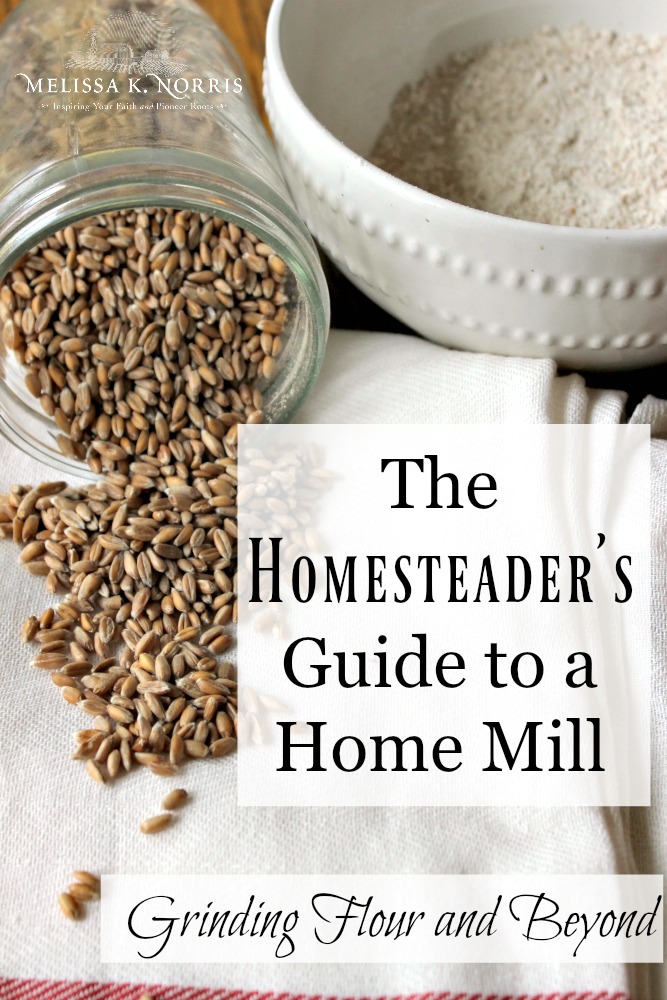Grinding your own flour at home is something everyone should be looking at, especially those of us who want to create whole foods at home that are as close to their natural state as possible and contain all of their nutrition.
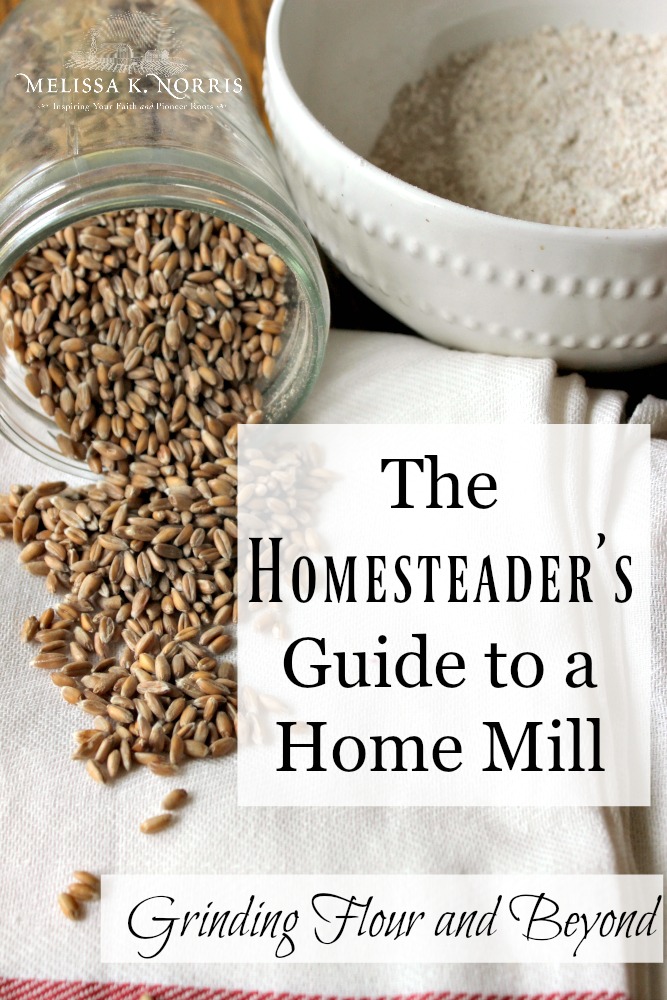
This my friends, is the Homesteader’s Guide to a Home Mill, because all good homesteaders know, that are tools need to work for us, and a home mill, isn’t just for flour, it’s for spices, vegetables, and so much more!
🍞 Struggling With Sourdough?
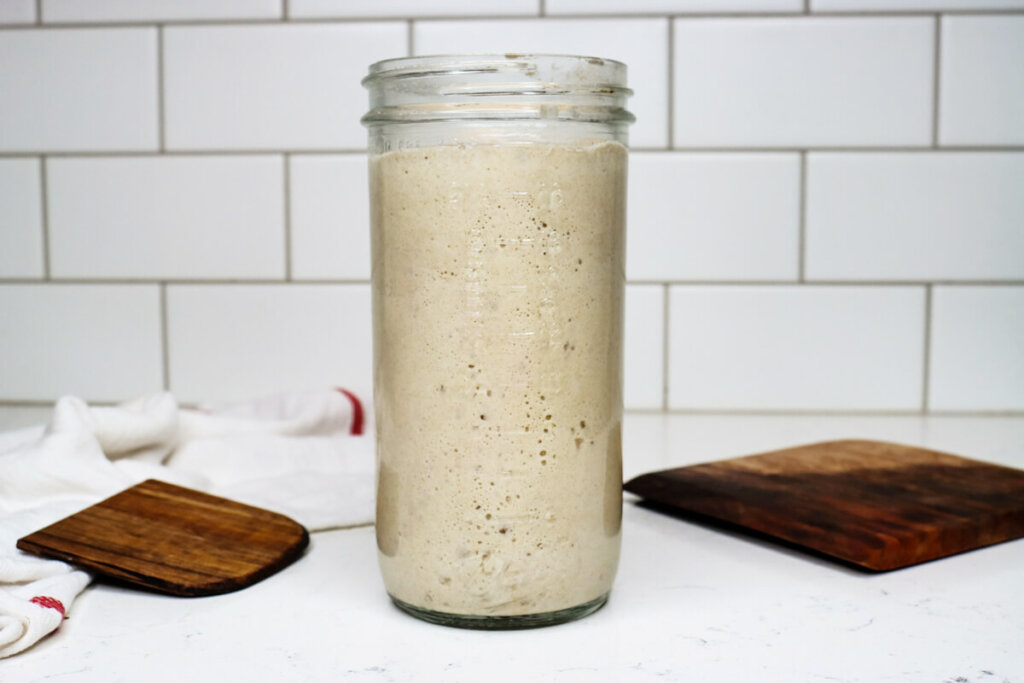
If your starter won’t take off, your loaves are dense and hard, or sourdough just flat-out overwhelms you…
👉 I’ll show you how to fix all of it.
Join my FREE live workshop and learn how to make a bubbly, active starter—the right way, from Day One.
🗓️ Jan 12 @ 1pm PT
Natural Remedies Made Simple
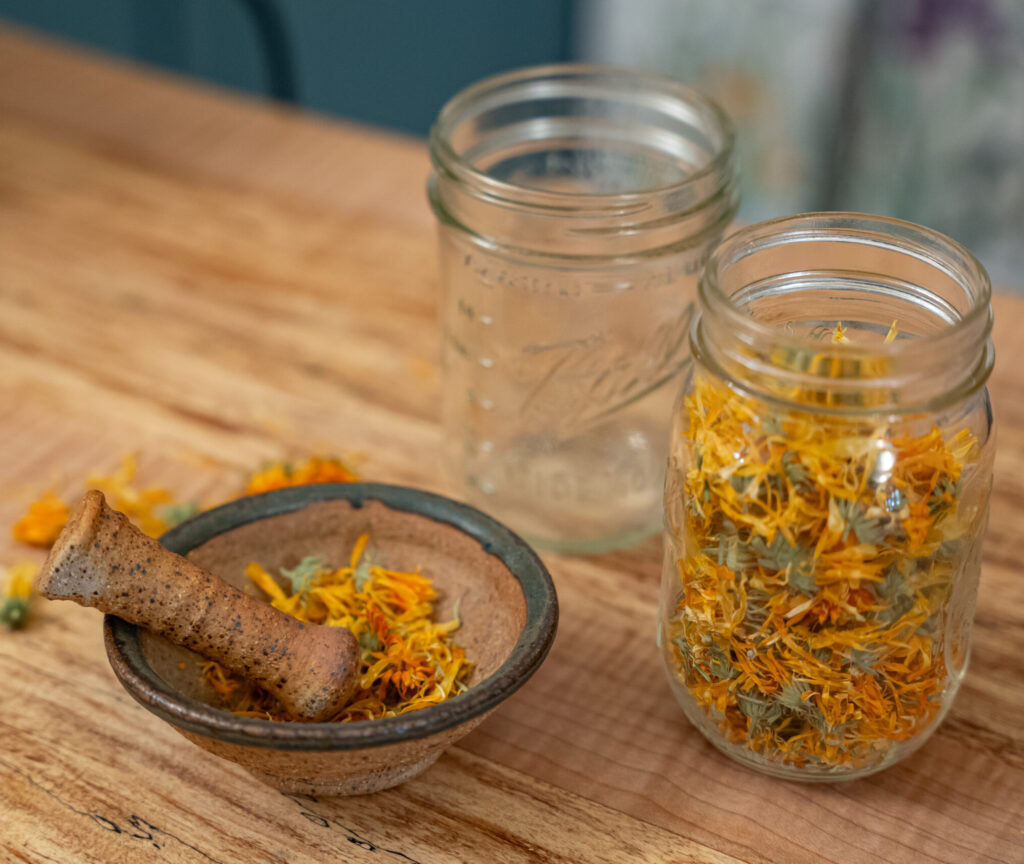
Start your home apothecary with confidence—even if you’re brand new. Learn how to choose the right herbs for your body using the simple principles of herbal energetics.
Discover how warming, cooling, drying, and moistening herbs affect your body—so you can stop guessing and start making remedies that actually work.
Welcome to podcast episode #120 the Homesteader’s Guide to a Home Mill, Grinding Flour and Beyond
Disclosure: the links below are affiliate links and I received my Mockmill for free in exchange for my honest review, read below for the true story
The fact is that five generations ago, our ancestors delegated something to industry that we firmly believe should never have been delegated to industry.
Paul
You can click on the links below to go straight to the specific sections, or read this post in its entirety.
Health Benefits of Fresh Ground Flour
Grinding Spices and Vegetables
Difference between types of burrs
Where to purchase a grain mill
I’ve been grinding my own flour at home for over 5 years now. Paul and I have a mutual friend, who is actually a grower of Einkorn, and you guys have heard Jade on the podcast before in Episode #111 Ancient Grain Einkorn- Health and Baking Guide
True story
Jade contacted me and he said, “Hey, my wife has this new mill, she’s madly in love with it. We would love for you to try it out and see what you think about it, because it’s actually coming to the US market.”
And honestly, I’m like, “You know, I’ve already got a mill.” I’m trying really hard not to have 100 different gadgets in my kitchen and home, to just really par down to the necessities in the things I use all the time. I was hemming and hawing, like, “Even though I can get it for free, I don’t really need another grain mill, though — mine is working just fine.” But he’s like, “I think you’re really going to be impressed with it.” And I said, “Okay, go ahead and send it to me.”
This podcast episode is sponsored by Mockmill. I said, “Go ahead and send it to me, I’ll give it a shot. I’ll see what I think about it.” I got it expecting, “Well, a flour mill is a flour mill, right? It grinds up your flour and it spits it out for you.”
But I was so impressed when I got the Mockmill and here’s why:
- I love that everything is all together, that it’s just one thing. (It only takes up 6 x 6 inches on the counter top!)
- I don’t have to hook a whole bunch of things together.
- The ability to adjust the grind that baby has, I could not believe how fine I could get it. And there’s so much play that I can just dial it in for the exact consistency that I want, from super pastry fine to course.
- It’s a lot quieter than the other mills that I have used.
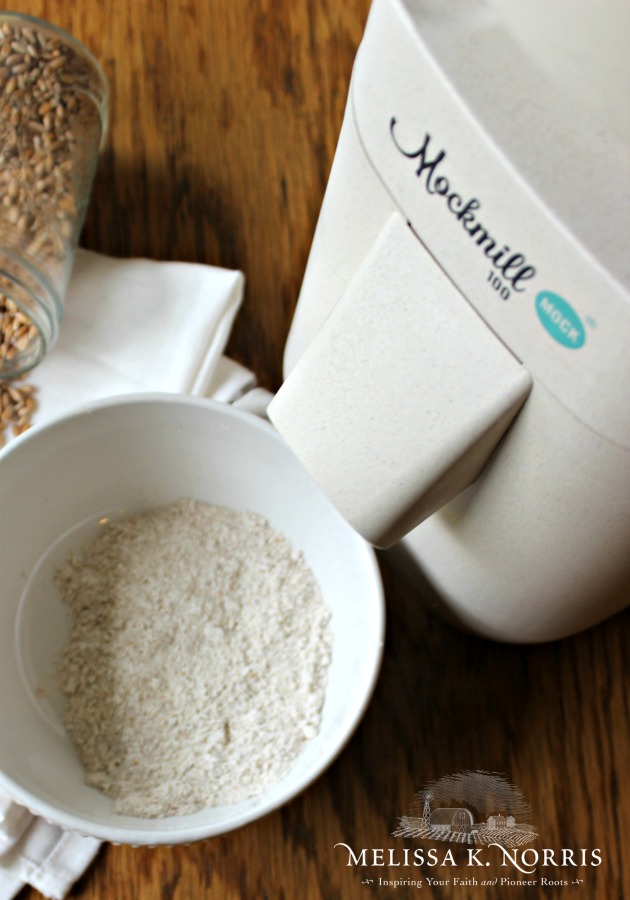
I was highly, highly impressed and this is officially my new mill, I”m giving my old one away.
4 Health Benefits of Fresh Ground Flour at Home
1.Store bought flour has all of the bran removed (where all of the nutrients are stored) in order to make it shelf stable, which means over tens of thousands of the phytochemicals (the minerals and vitamins) have been stripped. Yet, the government only requires three or four of those be put back in “enriched” in order to sell it. Store bought flour is missing huge components (in the thousands) of its original nutrition. (Source)
There is no way to get all of the nutrition in flour except by grinding it at home. Even organic and whole wheat flour from the store has been stripped in order to make it shelf stable.
2.The moment flour is ground and exposed to the air, it starts breaking down. To get all of the benefits from your flour, you want to grind it as you use it. The convenience of flour already ground has robbed it of its nutrients. You want to grind just the amount of flour you need for the recipe.
3.Taste. While you might not initially consider taste a health benefit, it most definitely is because if food tastes better, then your family members are more likely to eat it.
Highlight from the interview
Paul: It’s wrapped up in this intricate, totally mysterious packaging, that is what we call the bran, which is a multi-layered, interweaving of tens of thousands of discrete phytochemicals, each which has a role in preserving that life over those years, decades, and even centuries. That’s a marvel!
The interesting thing is that all those phytochemicals, as they work together in perfect harmony as described by nature, are good for us when we eat them, and so our whole civilization is based on our grinding those things up and eating them, and that’s a fact.
The moment you open up that package, that really intricate, marvelous package of nature, the goodness that it represents for us is headed downhill. And that’s a fact you can’t stop. The other thing is that if you disintegrate it, if you take parts out, select, keep this, put that over here, separate this, reduce this, add something here — you disrupt the perfect natural harmony of that food.
MKN: Every single package that you see on the store shelf, even if it’s organic and whole-wheat and whole grinds, when you see that bag, and it says the ingredients listed — and of course, when you’re looking at things like cereal and stuff — it all says “enriched.”
“When you buy flour from the store, no matter what it is, they’ve had to remove so much of it to make it shelf-stable. But they’ve removed the parts that are beneficial for us, the vitamins and everything, and so they have to enrich it back with vitamins so that we still have nutrition in there.
But because it’s not the original nutrition that’s in there, it’s been put back into it, then our bodies don’t absorb that or use that as well, as what you get when it’s all left in there, as God created it in its natural form. Well, we’ve had to add things back to it.
Paul: Exactly, it’s analog to organic farming, where we all understand that we can make plants grow if we only fertilize with nitrogen, phosphorus, and potassium, and forget the rest, and don’t pay attention to what we plant and whether we rotate. But the fact is when we do that, we get soil that’s devoid of anything but NPK.
That’s why, I hope, one of the big motivations there for homesteading, which I think is a fabulous movement, is there because people realize that they want to grow food in such a way that the soil can sustain that growing indefinitely.
This enrichment process is exactly the same thing; there are three or four nutrients that the government says have to be put back into flour when you strip it of its key natural nutrients. But that’s three of four, and yet, there’s tens of thousands I was talking about earlier that are missing — none of us will never know exactly what role they play. But the one thing we can be certain of is that they’re good for us.
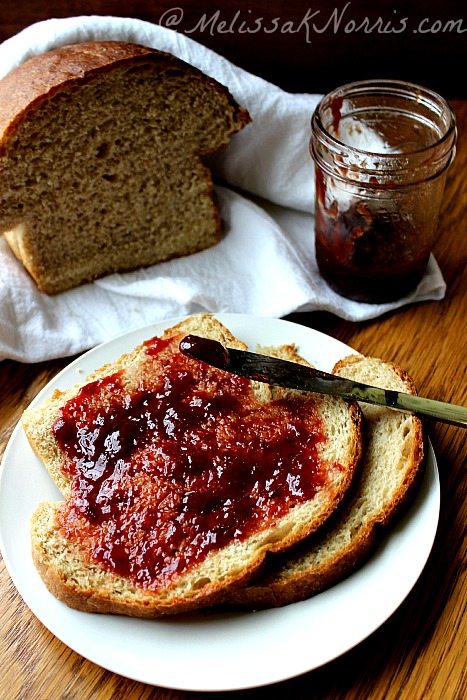
It doesn’t matter how healthy something is for us, if it doesn’t taste good, we’re not going to eat it, at least, not for very long. You have never experienced home baked bread until you make it with fresh ground flour.
Melissa K. Norris
4.Gluten free. For people with food allergies or sensitivities, it’s very important that their food doesn’t have cross-contamination with shared equipment. Grinding your own items at home ensures your flour hasn’t been in contact with anything you’re allergic to and really opens the door to different flour combinations, at a fraction of the price you pay in the stores.
You can grind:
- Chickpea flour, along with bean and pea flour
- Buckwheat flour
- Quinoa flour
- Oat flour
- Oatmeal/cracked oat groats
- Rice flour
- Millet flour
- Oil seeds (together with dry grains)
- Chia flour
- Sorghum flour
- Tapioca flour
- Corn flour
- Corn meal
- Teff flour
- Amaranth flour
It’s important to note that I am not a certified medical practitioner. This post is not intended to diagnose or treat but is for informational purposes only. Please contact your healthcare professional before introducing new herbal and natural remedies into your wellness routine.
Additional Uses for a Home Mill
1.Dehydrated vegetables. Grind up your dehydrated vegetables into a flour/powder. Sweet potato and root type vegetables work extremely well for this, dehydrate them into chips, dump them in the mill, and grind them into a powder.
2.Whole spices. You can use your grain mill to grind up your whole spices. Fresh ground black peppercorn is a completely different flavor than the ground pepper sitting on your pantry shelf.
3.Mustard. You can grind up your own mustard seeds to create an oily mustard paste.
To clean the mill after grinding spices, run a handful of rice through it. In the case of the oily mustard paste, you’ll have to take the mill apart and clean the stone burrs, but it’s a quick task, done in less than 5 minutes.
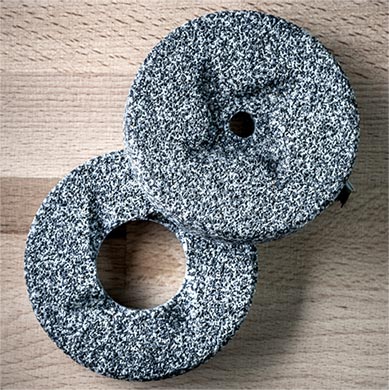
This is where the Mockmill is different than most electric home grain mills, you can easily take it apart and clean the burrs. Most other electric grain mills require you to ship them out, you cannot take them apart.
Why a stone mill is better
The burrs (what the food is ground against to become flour) are probably the most important part of your mill.
There are 3 different types of burrs on the market, steel, cast iron and stone.
Steel and cast iron burrs which do a decent job (this is what my old Wondermill had) but you can’t get as fine as grind and they heat up, causing the flour to come out hot (which some believe impacts the nutrition value).
How to Grind Flour at Home
The Mockmill really makes this quick work. You simply flip the switch, pour your grains into the hopper, and watch it shoot out into the bowl. Literally, it only takes a minute or two. Easy, peasy.
What really set the Mockmill apart for me was the ability to adjust the grain to the exact setting I want and need. The other mills I use only have three settings. With the Mockmill I can adjust it to exactly what I need and want, from course for cracked grains to very fine pastry flour, with up to 20 different settings if need be. (I confess, I’ve mainly been using it on super fine for baking, but a girl wants options)
Where to Buy Your Grain Mill
I don’t know about you, but I’ve never seen a grain mill sitting on the shelves next to the slow cookers (let’s hope that changes, and you and I, we’re the ones leading the much needed change, woot, woot!)
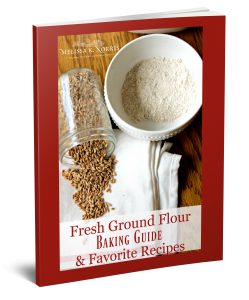
Hold up, I know that when you first start baking with fresh ground flour, you’ve got to make some adjustments to your favorite recipes. If you’ve been using store bought flour, you can’t just take 1 cup of fresh ground flour and use it in place of all-purpose flour and get the same bread or cookies.

There’s a learning curve… ask me how many loaves of bread turned out rock hard when I first started. But you my friend, you don’t have to suffer through those mistakes, because I’m sharing the tips I’ve learned to use fresh ground flour to convert your favorite recipes and get delicious food, every time.
And when you purchase the Mockmill, I’m giving you access to my mini e-course Baking with Fresh Ground Flour and my e-book Fresh Ground Flour Baking Guide & Favorite Recipes, valued at over $60!
You can have home milled flour in your kitchen and the bonuses with these 3 easy steps.
How to Order and Claim Your Bonuses
- Order your Mockmill here .
- Have your Mockmill Receipt number and fill out this form to get special access to my Fresh Ground Flour mini e-course and Fresh Ground Flour Baking Guide & Favorite Recipes.
- Begin creating the freshest flour you’ve ever had to bake wonderful foods for your family.
More Fresh Milled Flour Resources and Recipes
- Honey Whole Wheat Bread Easy Sandwich Bread Recipe
- Easy No Knead Artisan Bread Recipe
- Best Beginner Sourdough Sandwich Bread No Yeast
- Grandma’s Easy Homemade Dinner Rolls (With Fresh-Milled Flour)
- How to Store Homemade Bread (Stays Fresh Longer!)
- Tips for Better Bread Baking (no more dense or crumbly loaves!)
- Best Flour for Baking- Home Baker’s Flour Guide 101
- How to Choose the Best Grain Mill & Grind Flour at Home
- Where to Buy Grains in Bulk – My Favorite Sources
